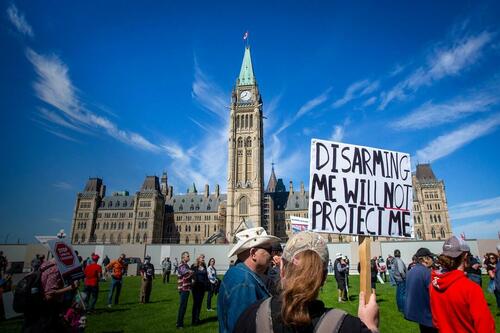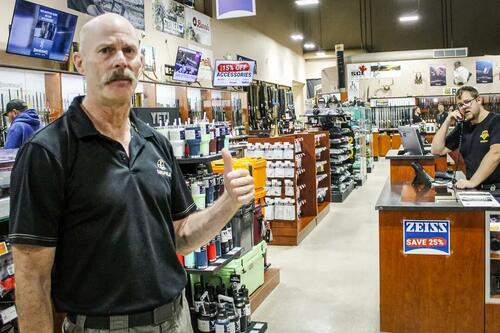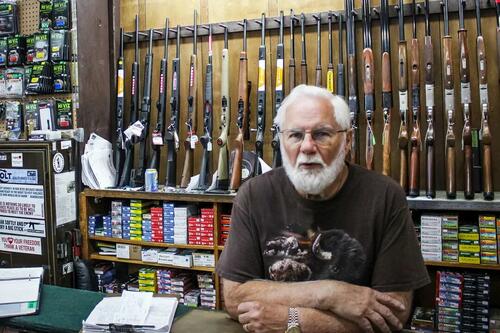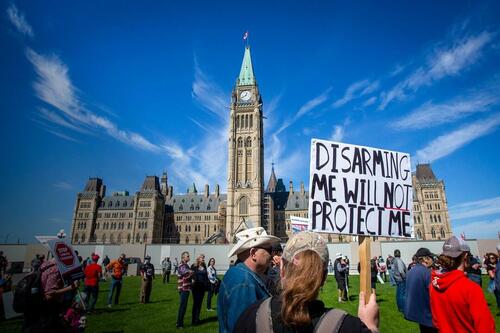Canada Banned Certain Guns, Can’t Figure Out How To Collect Them
Authored by Michael Clements via The Epoch Times (emphasis ours),
CALGARY, Canada—On May 1, 2020, the Canadian government outlawed 1,500 types of semiautomatic rifles and announced a firearms buyback program to take possession of the newly banned guns.

The action was the federal government’s response to a mass shooting in Nova Scotia in which 22 people were killed over April 18–19, 2020.
The killer, dressed as a Royal Canadian Mounted Police officer and driving a car rigged to look like a patrol car, used an AR-style rifle smuggled into Canada from the United States.
Four years later, as Prime Minister Justin Trudeau’s Liberal Party struggles to keep control in Parliament, both sides of the debate anticipate the possible end of the program even before the first gun has been surrendered.
One gun control activist has criticized the buyback program as too weak.
Nathalie Provost is the spokesperson for PolyRemembers, a group formed after the Dec. 6, 1989, mass shooting at the Polytechnique engineering school in Montreal that killed 14.
Provost, a survivor of that crime, did not respond to The Epoch Times’ request for comment.
In a Sept. 11 statement, she called on the government to eliminate exemptions to the ban, accelerate completion of the buyback, and close loopholes in the law.
“Even the mandatory buyback program … will lose all of its meaning if current [gun] owners … can simply take the money from the buyback to purchase [guns] that remain legal or new models introduced … by manufacturers seeking to increase their sales and profits,” Provost wrote.
Under the program, certain automatic and semiautomatic rifles, so-called assault weapons, were banned.
Rifles such as the AR-15, AK-47, and similar types can no longer be bought, sold, imported, or even transported in Canada. The plan calls for owners of the now-illegal guns to sell them to the federal government.
The government established a two-year amnesty period during which owners must securely store their prohibited firearms until the logistics of the buyback program are worked out.
In 2022, the amnesty period was extended to October 2025.
James Bachynsky, president of the Calgary Shooting Center since 2011, said the Nova Scotia shooting was simply used as an excuse for the Liberal Party to institute a ban it wanted all along.
Bachynsky said the ban would not have prevented the killings in Nova Scotia.
He pointed out that the killer had violated several laws before he fired his first shot. From smuggling guns into the country to impersonating a police officer, the shooter could have been charged with a crime without ever putting his finger on a trigger, he said.
“The government wanted to be seen to be doing something. They introduced this [Order in Council], banned all these guns, and then the investigation determined that all [the killer’s] guns had been smuggled in over the U.S. [border] anyway,” Bachynsky told The Epoch Times.

Brian Kent agrees. He owns Proline Shooters II in Calgary and has been in the firearms business for 42 years. He said restricting legal gun ownership is the easiest way for the government to give the impression that it is doing something.
Kent says he believes the “government wants to do away with all firearms,” and people who own guns legally are “low hanging fruit and … easy to pick on.”
During a Sept. 19 meeting, Dominic LeBlanc, Minister for Public Safety, Democratic Institutions, and Intergovernmental Affairs, denied these claims when questioned by Conservative Sen. Yonah Martin.
“This program in no way targets sports persons, or indigenous persons or persons who hunt for sustenance or who practice a sport; this is designed to get military weapons off the streets,” LeBlanc said.
But Kent is not convinced.
He said officials use terms such as “assault weapons,” “military weapons,” and “weapons of war” to alarm and confuse their constituents. The difference between the banned guns and legal guns is a matter of form rather than function, he said.
“There’s no difference between a [prohibited] AR-15 system and a [legal] Remington 742 semiautomatic rifle. There’s no difference in the function,” Kent told The Epoch Times. “The AR-15 looks dangerous and military and ‘oh my goodness, we’re going to all die.’ There’s no actual functioning difference between the two firearms.”
Bachynsky said that as a firearms dealer, he keeps track of changes in the gun laws. He said the buyback program is confusing. According to Bachynsky, the changes could catch some gun owners unaware.
The list of prohibited rifles has grown from 1,500 to almost 2,000 over the past four years. This means that rifles that were legal when the list was written in 2020 may no longer be allowed.
“But if you own any kind of semiautomatic rifle now, or even a hunting rifle, you need to check [the restricted firearms list] regularly to see whether it’s become prohibited,” Bachynsky told The Epoch Times.

The program is divided into two phases. In the first phase, gun stores will sell to the government any stock they haven’t been able to export or sell before the amnesty period ends. In the second phase, individual owners will sell their prohibited guns to the government.
In each case the price will be determined by a government estimate, not the amount the store or owner paid.
As of Sept. 25, the Public Safety Canada website had no details on how or when either phase would begin.
“More information on the methods affected firearms businesses can use to turn in their inventory and how they can participate in the program will be provided at a later date,” the Public Safety Canada website reads.
In December 2023, the government enacted Bill C-21, which codified the plan’s prohibition on the sale or transfer of handguns.
Current handgun owners can transport their handguns to shoot on approved firing ranges. But they cannot sell or give them to anyone. When current handgun owners die, their guns must be handed over to the government.
The Liberal Party has been able to advance its agenda through an agreement with the New Democratic Party (NDP). However, on Sept. 4, the NDP backed out of the agreement.
Read the rest here…
Tyler Durden
Thu, 10/03/2024 – 17:40

